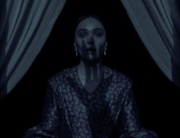
In a decade where cult-driven films have increased, such as Ari Aster’s Midsommar and Gareth Evans’s Apostle, it’s refreshing at first to see director Malgorzata Szumowska subvert audience’s expectations with her English-language debut, The Other Lamb, by having a story centered around an all-female cult of mothers and daughters led by a Jesus-like figure.
Throughout the slow-paced yet eerie 97-minute runtime, the focus centers on teenager Selah (Raffey Cassidy), whose mother died during childbirth, and the sect Selah was born into is all she has known. As a sudden series of nightmarish visions and revelations occur inside her mind, questions arise about Selah’s existence, and more importantly, the allegiance to the controlling cult leader, Shepherd (Michiel Huisman), and his followers. She begins to feel uncomfortable around him and the actions committed by him and his followers.
While the story line may have a ton of intrigue surrounding it, it also has clichés found in plenty of cult films: the one character who pretends to be part of the group but who in reality wants out before it’s too late. Here that’s a cult member (played by Denise Gough) who spills the details about why Selah needs to step away from the group. Along with the remaining story beats, the execution ends up becoming very hollow, with underplayed stakes and a transparent and subdued villain.
To say the film is an entirely bland watch would be a lie, because of the overall praise that the performances, cinematography, and production design heavily deserve. After a brilliant turn in Yorgos Lanthimos’s The Killing of a Sacred Deer, Cassidy elevates the movie with a haunting performance. She has the ability to balance restraint and fear in these two psychological thrillers. She’s an actress to keep an eye on.
This is a visually striking picture, courtesy of cinematographer Michael Englert showcasing the hauntingly eerie, remote environment of the misty woods, the film’s primary location, as well as the stark, pale blue saturated production design. Despite those praise-worthy aspects, the snail-like pacing makes it excruciatingly tough to sit through, and the screenplay lacks any form of emotional heft, mainly due to the lack of surprise or originality. Despite its art house trappings, the script includes arcs that mirror many films in this subgenre.
Since we’ve seen many cult-driven movies, it would’ve been fascinating to see a unique approach to it, especially since there aren’t a lot of films in this genre that are female led. Yet by the time the end credits began to roll though, I was mostly taken aback by how lackluster Szumowska decided to conclude this story.
















Leave A Comment